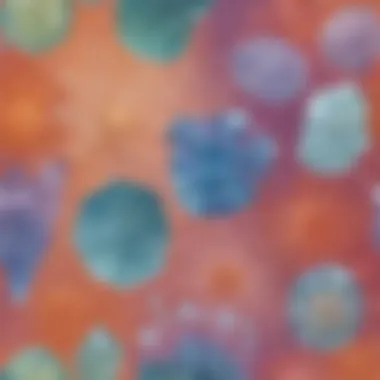Unveiling the Intriguing World of Chemistry Experiment Kits: A Comprehensive Guide for Young Minds


Science Fun Facts
Chemistry is all around us in the food we eat, the air we breathe, and the objects we interact with daily. Did you know that an average person's body contains enough iron to make a medium-sized nail? Or that the chemical reaction between vinegar and baking soda produces carbon dioxide gas, creating those fizzy bubbles? These fun facts demonstrate the fascinating and practical aspects of chemistry that young science enthusiasts can explore and discover in experiment kits.
Discover the Wonders of Science
Immerse yourself in the world of scientific exploration through chemistry experiment kits designed to captivate budding young scientists aged 6-12. From understanding the basics of chemical reactions to delving into the principles of molecular structures, these kits offer interactive learning tools that engage children in hands-on experiments, educational videos, and real-life applications of science. Unleash curiosity and unlock the potential for a lifelong love of learning through engaging STEM experiences.
Science Quiz Time
Challenge your knowledge and critical thinking skills with interactive quizzes tailored to spark curiosity and deepen understanding of scientific concepts. Engage in multiple-choice questions that test your comprehension, unravel brain teasers that stimulate problem-solving abilities, and unravel puzzles that offer a fun learning experience. Embrace gamification as a tool for enhancing scientific knowledge, making learning enjoyable and rewarding for young learners.
Science Experiment Showcase
Embark on a journey of discovery with a showcase of fun and engaging experiments that bring chemistry to life in accessible and exciting ways. Follow step-by-step instructions to conduct experiments that demonstrate chemical reactions, explore states of matter, and uncover the secrets of the periodic table. Equip yourself with a materials list detailing the essential components for each experiment, ensuring safety tips and precautions are adhered to for a secure and enriching scientific exploration.
Introduction
In the fascinating realm of chemistry, experiment kits stand as gateways to a world filled with scientific wonders. This article is a comprehensive guide tailored for young science enthusiasts aged 6-12, aiming to ignite their curiosity and nurture a passion for learning. By delving into chemistry experiment kits, children can explore various scientific concepts and principles hands-on, paving the way for a deep understanding of the intricate world of chemistry.
Understanding Chemistry Experiment Kits
Overview of Chemistry Kits


Chemistry kits offer a hands-on approach to learning by providing curated experiments and activities that engage young minds. These kits encompass a wide range of experiments, from simple reactions to complex molecular structures, ensuring a diverse learning experience. The key characteristic of chemistry kits lies in their ability to make abstract scientific concepts tangible and easily comprehensible for young learners. By offering a structured pathway to explore chemistry, these kits serve as invaluable tools for nurturing scientific curiosity and understanding.
Benefits of Using Chemistry Kits
Utilizing chemistry experiment kits has proven to be highly beneficial in enhancing children's learning experience. These kits not only instill a love for science but also foster critical thinking and problem-solving skills. By engaging in hands-on experiments, young individuals can actively apply theoretical knowledge to practical scenarios, thereby reinforcing their understanding of scientific principles effectively. The unique feature of chemistry kits lies in their interactive nature, creating an immersive learning environment that promotes curiosity and exploration.
Importance of Hands-On Learning
Enhancing Understanding Through Experiments
Hands-on experimentation is fundamental in deepening a child's comprehension of scientific concepts. Through direct engagement with experiments, children can visualize abstract theories in action, leading to a more profound understanding of chemistry. The key characteristic of hands-on learning is its ability to bridge the gap between theory and practice, allowing young learners to grasp complex concepts with ease. By actively participating in experiments, children can solidify their knowledge and develop a profound appreciation for the wonders of chemistry.
Promoting Critical Thinking Skills
The significance of hands-on learning in promoting critical thinking skills cannot be overstated. By encouraging children to analyze results, draw connections, and make predictions based on their experiments, hands-on learning cultivates a sharp and analytical mindset. The key characteristic of this approach lies in its ability to challenge young minds to think creatively and logically, developing their problem-solving abilities. By actively engaging in experiments, children can enhance their critical thinking skills, preparing them to tackle complex scientific challenges with confidence and ingenuity.
Types of Chemistry Experiment Kits
Chemistry experiment kits play a crucial role in nurturing young minds and fostering a passion for science. These kits serve as a gateway for budding scientists aged 6-12 to explore the wonders of chemistry through interactive and hands-on activities. By delving into basic and advanced chemistry kits, children can gain a solid foundation in scientific concepts while honing their critical thinking and problem-solving skills. Choosing the right chemistry kit is essential to ensure a safe and engaging learning experience for young learners.
Basic Chemistry Kits
Introduction to Chemical Reactions
Introducing children to chemical reactions is a fundamental aspect of basic chemistry kits. This section focuses on creating a hands-on experience where young learners can observe and understand how different substances interact, transform, or combine to form new compounds. By conducting simple experiments like mixing acids and bases or observing color changes in reactions, children can grasp the fundamental principles of chemistry in a fun and engaging manner. The emphasis on chemical reactions in basic chemistry kits reinforces the concept of cause and effect, sparking curiosity and encouraging further exploration into the world of science.


Exploring Elements and Compounds
Exploration of elements and compounds is another crucial component of basic chemistry kits. This aspect enables children to identify common elements, understand the properties of different compounds, and appreciate the building blocks of matter. By providing hands-on activities that involve classifying elements, conducting tests to differentiate between substances, and creating simple compounds, basic chemistry kits lay the foundation for a deeper understanding of the periodic table and chemical bonding. Through exploring elements and compounds, young scientists can develop observation skills, analytical thinking, and a curiosity for experimentation, preparing them for more advanced studies in chemistry.
Advanced Chemistry Kits
In-Depth Experiments on Molecular Structures
Advanced chemistry kits offer challenging experiments that delve into the intricate world of molecular structures. By introducing concepts such as molecular geometry, bonding theories, and structure-property relationships, these kits enable young learners to explore the complexities of chemical interactions at a deeper level. Conducting experiments on molecular structures allows children to visually comprehend abstract concepts, predict molecular behaviors, and enhance their spatial reasoning skills. The emphasis on in-depth experiments in advanced chemistry kits not only reinforces theoretical knowledge but also cultivates a practical understanding of how molecular arrangements influence chemical properties and reactions.
Chemistry in Everyday Life
Bringing chemistry to life through real-world applications is a key focus of advanced chemistry kits. This section emphasizes the relevance of chemistry in everyday scenarios, such as food preparation, environmental conservation, or pharmaceutical developments. By engaging in hands-on projects like testing water quality, analyzing food components, or synthesizing simple products, children can grasp the practical implications of chemistry in various industries. Exploring chemistry in everyday life not only broadens young scientists' perspectives on the subject but also highlights the interdisciplinary nature of science, encouraging them to connect theoretical knowledge with real-world experiences.
Choosing the Right Chemistry Kit
In this section of \
Benefits of Chemistry Experiment Kits
Chemistry experiment kits offer a myriad of benefits for young science enthusiasts aged 6-12, making them an invaluable learning tool in this article. These kits not only provide a hands-on experience but also nurture curiosity and critical thinking skills. By actively engaging in experiments, children can grasp complex scientific concepts in a tangible way, enhancing their understanding and retention.
Educational Value


Hands-On Learning Experience
The hands-on learning experience is a pivotal aspect of chemistry experiment kits discussed in this article. It allows children to interact directly with materials, fostering a deeper connection to the subject matter. Through hands-on experiments, young learners can observe chemical reactions firsthand, solidifying their comprehension of scientific principles. This experiential approach not only boosts engagement but also encourages a practical application of theoretical knowledge.
Application of Scientific Concepts
Another crucial element of chemistry experiment kits is the application of scientific concepts. By exploring these kits, children can directly apply theoretical knowledge to real-world scenarios, bridging the gap between classroom learning and practical application. This hands-on approach enables young scientists to understand the relevance of chemistry in everyday life, stimulating their curiosity and encouraging further exploration.
Skill Development
Enhancing Problem-Solving Skills
Enhancing problem-solving skills is a key feature of chemistry experiment kits highlighted in this article. Through conducting experiments and analyzing results, children are challenged to think critically and find solutions to scientific puzzles. This process not only sharpens their problem-solving abilities but also instills a sense of resilience and perseverance when faced with challenges.
Encouraging Creativity
Encouraging creativity is another significant aspect of chemistry experiment kits discussed in this article. By engaging in hands-on experiments, young scientists are encouraged to think outside the box, explore new ideas, and innovate. This creative freedom not only enhances their scientific skills but also nurtures a sense of curiosity and imagination, laying the foundation for future scientific endeavors.
Conclusion
In wrapping up this comprehensive guide on chemistry experiment kits for young science enthusiasts, it becomes evident that these educational tools play a pivotal role in igniting curiosity and nurturing a love for scientific exploration. The importance of concluding this article lies in summarizing the significant aspects discussed throughout the content, emphasizing the transformative impact these kits can have on young minds. From providing hands-on learning experiences to fostering critical thinking skills, the conclusion encapsulates the essence of why chemistry experiment kits are indispensable for young learners.
Encouraging Young Scientists
Fostering Curiosity and Exploration
Delving into the realm of fostering curiosity and exploration within young scientists unveils a fundamental aspect of scientific development. This specific element serves as a catalyst for sparking interest and inquisitiveness in budding science enthusiasts. By encouraging a sense of wonder and exploration, fostering curiosity and exploration instills a proactive attitude towards learning. Its key characteristic lies in promoting engagement and proactive questioning, which are essential for a comprehensive learning experience. The unique feature of fostering curiosity and exploration is its ability to cultivate a mindset of continuous inquiry, nourishing a genuine interest in discovering the unknown. While the advantages include promoting a deeper understanding of scientific principles and enhancing problem-solving skills, a potential disadvantage may be the risk of distraction if not properly guided within the educational context.
Inspiring a Lifelong Love for Chemistry
Moving on to discussing the theme of inspiring a lifelong love for chemistry among young learners sheds light on the enduring impact of early exposure to this field of science. This specific aspect serves to instill a lasting passion and appreciation for the intricacies of chemistry, transcending mere academic boundaries. The key characteristic of inspiring a lifelong love for chemistry lies in forging a personal connection with the subject matter, making it a relatable and captivating field of study. Its unique feature lies in fostering a sense of wonder and awe towards chemical phenomena, instigating a desire for continuous exploration and discovery. The advantages of inspiring a lifelong love for chemistry include nurturing a deep-seated interest in the subject and potentially guiding future career choices towards scientific disciplines. However, a possible drawback could be overemphasis on one scientific area at the expense of broader scientific knowledge and exploration.







